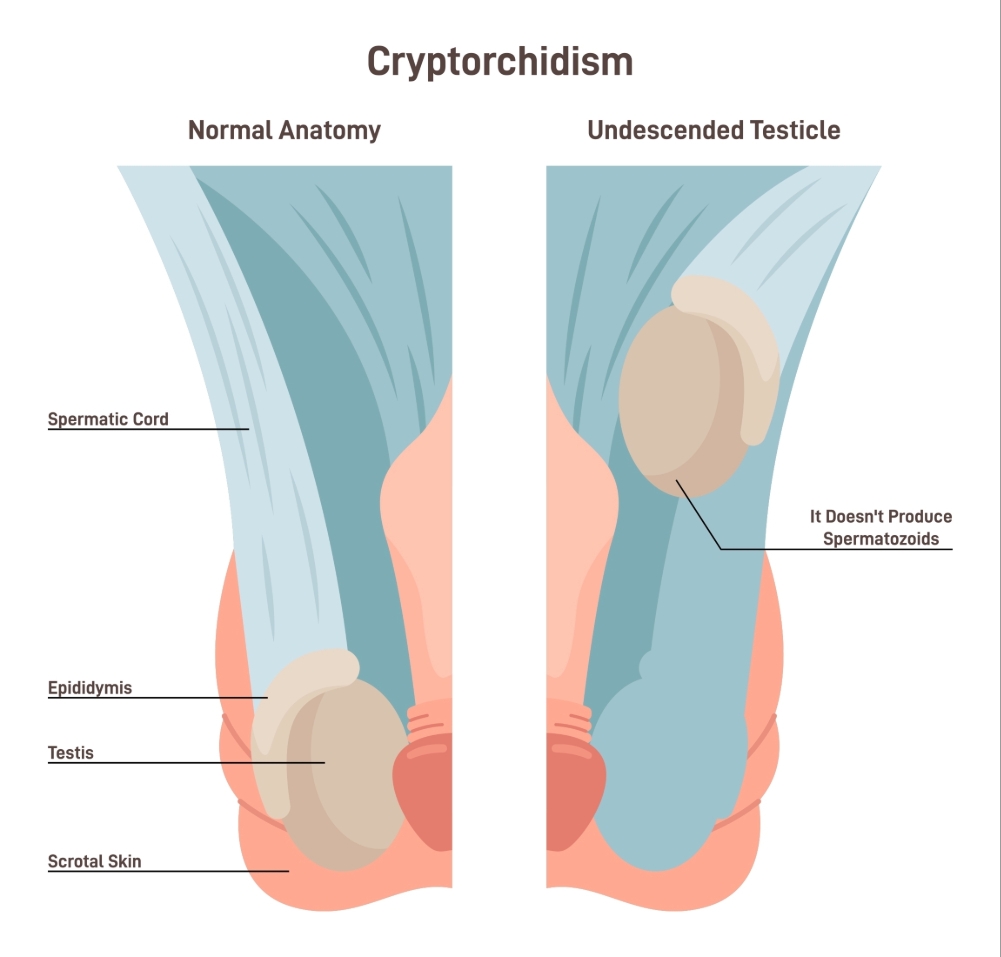Cryptorchidism, also known as undescended testicle, is a condition when one or both testicles do not move into the scrotum before a child is born or a few months after birth. During pregnancy, testicles form in the baby’s stomach and move into the scrotum a few months before the baby is born. When this is interrupted or delayed, a child is born with an undescended testicle. This condition affects ~3% of babies, but more commonly affect babies born prematurely, with up to 30% of premature babies having cryptorchidism.
A cryptorchidism may be diagnosed as:
- Testicular retraction: When the testicle moves between the scrotum and the abdomen. This is the most common reason for an inaccurate diagnosis of an undescended testicle.
- Canalicular testis: When the testicle is above its natural position in the scrotum, but outside the abdominal cavity.
- Intra-abdominal testes: When the testicle is inside the abdominal cavity in a position along its pathway of natural descent. When in this position, it is not ready for future examination, and it is at risk of becoming cancerous.
- Ectopic testicle: When the testicle may be found in regions not in the usual pathway of descent into the scrotum. Five common regions include perineum, femoral canal, superficial inguinal pouch, suprapubic area, and contralateral scrotal pouch.
- Absent testicle: When one or both testicles are absent from either side.

Cryptorchidism Symptoms
The main symptom of undescended testicles the absence or incorrect location of one or both testicles. There are typically no other signs that are associated with this condition.
Causes & Risk Factors for Cryptorchidism
While it is unknown what exactly causes an undescended testicle, genetics, the mother’s health, or environmental factors may impact the hormones that develop the testicles.
Risk factors for cryptorchidism include:
- Premature birth
- A family history of undescended testicles
- Certain newborn conditions, such as cerebral palsy
- Maternal health, such as diabetes
- Alcohol consumption during pregnancy
- Maternal and paternal smoking during pregnancy
- Certain medications, related to or unrelated to pregnancy
Prevention Strategies for Cryptorchidism
There is no exact way to prevent undescended testicles. With that said, it is important for the mother to engage in a healthy lifestyle during pregnancy to decrease the risk. Some ways to do this include engaging in regular checkups, not smoking or consuming alcohol, or following certain dietary restrictions.
Evaluation and Treatment for Cryptorchidism
Evaluation of cryptorchidism includes:
- Ultrasound: Used to identify a testicle located in the inguinal canal. This is limited to intra-abdominal testes.
- MRI and CT scan: Used for intra-abdominal testes. They are often difficult to use on small children and have a high false negative result.
- Hormonal work-up: Required if the patient is less than nine years old and has bilateral undescended testes. This tests for bilateral anorchia, when the testes do not form on either side. If results are normal, an HCG stimulation test is applied, and testosterone is measured.
Treatment for the undescended testicle is recommended before the baby turns 1 year old as early damage to the cells that produce sperm starts at this age. Other reasons to treat at that time include psychological impacts as well as the risk of physical examination leading to testis cancer.
Non-surgical treatment options
- Pharmacotherapy: This is the treatment of undescended testicles using pharmaceutical drugs. Advantages include avoiding anesthesia and it being minimally invasive. HCG (human chorionic gonadotropin) is the recommended drug for undescended testicle as it stimulates Leydig cells to produce male hormones, but the precise mechanism of action is unknown. While this may lead to testicle descent in some, the success rates have been reported to be as low as 10%, with diminished success in children under two years old. Patients failing hormonal therapy after 5 weeks should have surgical treatment.
Surgical treatment options
The most effective treatment for undescended testicles is surgery, which can be performed as an outpatient. It is important to note that surgery is immediately needed for ectopic testes, cryptorchids with coexisting hernias and children at pubertal age. Surgical treatment options include:
- Inguinal region incision: A small incision made in the skin above the scrotum when a testis is in the groin area. Most undescended testes are associated with a hernia that must be repaired. After this is done, the testis is brought down into the scrotum and anchored in a space created in the scrotum (orchiopexy). Both incisions (in the inguinal region and scrotum) are closed with absorbable sutures.
- Orchiopexy: After the inguinal region incision is made, the undescended testicle is moved and anchored into the scrotum. This incision is closed with absorbable sutures.
- Concealed Laparoscopic Orchiopexy: Laparoscopy can be used to localize nonpalpable, undescended testes. The laparoscopy is performed first to see if whether the testicle is in the abdomen or if it is completely absent. If it is low in the abdomen, an orchidopexy is performed laparoscopically, which involves a laparoscope being inserted through a small umbilical opening to locate the testis. If the testis is healthy, a second instrument is placed through a small opening in the scrotum to move the testicle into its natural position. If the testicle is too high in the abdominal cavity to reach in a one-step operation, it will be freed of its previous blood supply and placed in a location such that it can be brought down with a second operation performed in 6 months.
Long-term complications of the treatment of undescended testicles include infertility and tumorigenesis, initial forming of tumors. After the initial post-operative visits, children should be seen 1 year after surgery to check the testes’ location and size. At puberty, children should be taught how to perform monthly testicular self-examinations. Once the boys reach adulthood, concerns regarding fertility should be discussed with a urologist.
